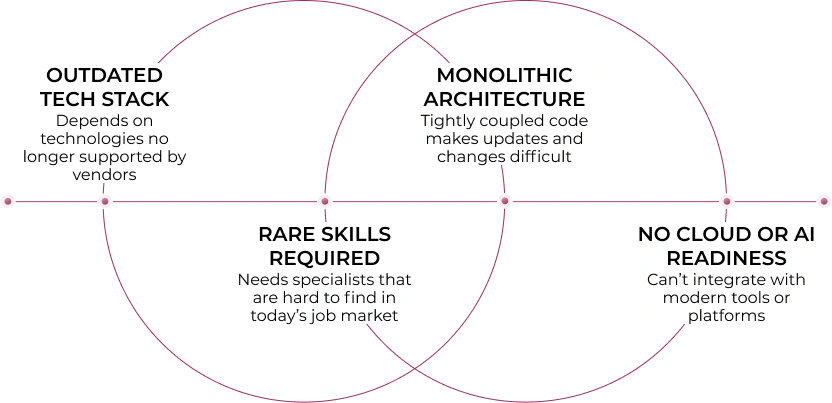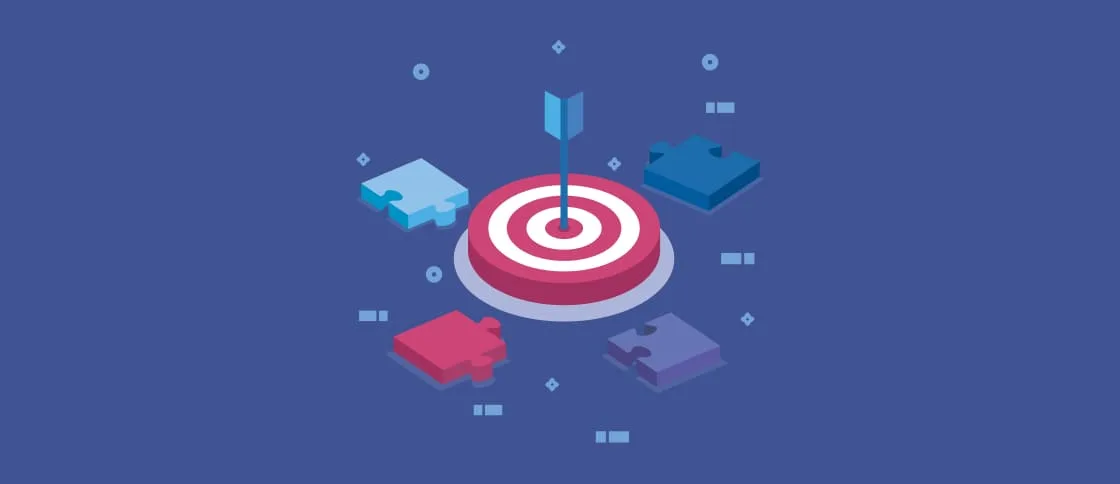- Key Takeaways
- Defining the Legacy Problem and Why It Persists
- Sign 1: Security Exposure in Legacy Systems Leading to Data Breaches
- Sign 2: Information Trapped in Data Silos Undermines Decisions
- Sign 3: Integration Issues and Compatibility Issues Block Modern Tools
- Sign 4: Rising TCO From Aging Hardware and Software
- Sign 5: Legacy Applications Throttle Growth Across Business Systems
- From Quick Wins to Full Legacy System Modernization
- Managing Modernization Risk: Testing, Rollout, and Training for Business Continuity
- Planning the Cutover: Data Migration Without Chaos
- Softacom Can Help
- Conclusion
Many applications that are still in use today were written decades ago. Some of them started as student projects and became business-critical. They carry important logic and daily workflows.
But technologies are also evolving by the day. And the world has changed many times since those applications were developed. Today, not only users expect them to be faster, more flexible and better designed. The industry standards expect them to be secure enough to protect sensitive information and be compliant with regulations.
Legacy systems tend to keep businesses running long after their prime but at a hidden cost. For IT leaders and product owners, the question is not if but when outdated systems begin dragging performance, security and innovation down.
In this article, we explore five indicators that your legacy software is hurting your business. You will learn how to identify problems and understand their impact on business. Also, we will illustrate how to apply short-term fixes and long-term modernization efforts.
By the end, you will have a practical checklist of red flags and a clear way forward to controlled modernization.
Key Takeaways
- Security risks multiply when outdated software lacks patches and support.
- Data silos entrap insights and prevent sound decisions and customer experiences.
- Barriers to integration block new technologies and slow down digitalization.
- Increasing TCO (Total Cost of Ownership) makes legacy software more expensive.
- Legacy applications slow down growth.
Defining the Legacy Problem and Why It Persists
When people talk about legacy systems, they usually call them “old software” or “software written in old code.” But it is more than that age alone. It is many factors that make it clear. The situation has changed. And if the company wants to keep running, it has to update its software.
A system becomes legacy when it depends on technology that vendors no longer support. When it runs on monolithic or tightly coupled code, that complicates the introduction of changes. Or when it requires skills that are increasingly rare in today’s job market. It is also a legacy problem if it can’t adopt modern technologies like cloud or AI.

Yet, these applications are still everywhere. Banks, hospitals, manufacturers, and government agencies keep relying on them every day. Why? Let’s see:
- Companies have already sunk millions of dollars into the development of their systems. It is not easy to walk away from such a huge investment. Many of these applications also serve specific business functions that still “work” well enough to keep lights on.
- Fear plays a big role. Migration projects carry a reputation for being risky and disruptive. That fear leads to a “better not touch it” approach.
- Then there is culture. Many organizations live by the old saying: “If it is not broken, don’t fix it.” A legacy technology might not look broken from the outside. But it quietly creates risks and inefficiencies under the surface. And these risks grow larger each year.
The decision often comes to a trade-off. Staying put feels familiar and safe. But it increases the chance of security breaches and high maintenance costs. Controlled modernization, on the other hand, may involve some disruption and upfront cost. But it pays back with compliance and long-term savings.
Here’s a simple way to look at it:
| Choice | Risk | Reward |
| Stay with legacy tech | Security breaches, rising costs, talent loss | Short-term stability |
| Controlled modernization | Some temporary disruption, investment needed | Long-term savings, growth, compliance |
The real danger is standing still. It may feel like the safe option. But inaction means trusting your business to technology that is steadily falling behind. Modernization doesn’t have to mean replacing everything overnight. It can start with small and controlled steps that reduce risk and build confidence along the way.
Let’s talk about legacy problems that hurt your business.
Sign 1: Security Exposure in Legacy Systems Leading to Data Breaches
Security is usually the first problem with current legacy systems. Old applications often run on components that no longer receive updates. Vendors stopped operating long ago. Such systems may rely on outdated authentication methods like NTLM or Basic Auth. They might have scattered and inconsistent access controls. But security vulnerabilities pile up. And without patching, you are leaving the door open for malicious actors.
The consequences are painful. Data breaches lead to customer mistrust and regulatory penalties that drain your budget. Even if nothing has gone wrong yet, the risk grows every day.
There are quick steps you can take. You can patch faster, isolate sensitive systems, enforce multi-factor authentication and rotate credentials more often. But long-term safety means rethinking your security completely. Encrypting data everywhere and re-architecting will give you protection.
Sign 2: Information Trapped in Data Silos Undermines Decisions
If you have ever had two departments give you completely different reports for the same metric, you understand. One of the disadvantages of outdated legacy systems is that they might freeze data in formats that don’t coexist well with others. Teams work around it with CSV exports and copy-and-paste. Rather than a single source of truth, you end up with multiple conflicting ones.
This slows down the speed of making decisions. And customers feel the impact when sales and support don’t have common information. The company with a legacy system is flying blind.
Short-term fixes are possible. You can set up pipelines to transport data into a central place. You can apply data virtualization to create a unified view or build a shared catalog. The long-term answer, though, is standardizing data. That means building canonical models and defining governed domains so information flows in real time.
Sign 3: Integration Issues and Compatibility Issues Block Modern Tools
Modern tools are built to connect. But legacy software rarely can. Old systems often require custom middleware or tight coupling between modules. That’s why attempts to integrate with new SaaS platforms or cloud services often fail. They cost more than expected or take months longer than planned.
When integrations don’t work, business initiatives stall. Teams may even turn to shadow IT – buying their own tools outside official channels. Partnerships suffer too. Bringing in a new vendor or third-party system is harder than it should be.
You can buy some breathing room with API gateways. But if you want a lasting solution, the architecture of the legacy system itself needs to change. Decoupling via events and applying the “strangler pattern” to slowly replace old modules helps businesses keep moving forward without waiting for a big-bang replacement.
Sign 4: Rising TCO From Aging Hardware and Software
One of the biggest misconceptions about legacy systems is that they’re “cheap” because they are already paid for. In reality, the longer you keep legacy systems, the more expensive they get. Vendors charge extra for extended support. Licenses climb for outdated software. The specialized skills needed to maintain them are harder and costlier to find. Add in downtime from fragile infrastructure, and the costs add up fast.
If you want a clear picture, build a TCO (Total Cost of Ownership) model that includes the obvious costs. For example, hardware, hosting, and support contracts and hidden ones like risk exposure and lost productivity. Often, you will discover that legacy system modernization pays for itself faster than expected.
There are also short-term savings you can grab right away. Consolidating environments or replacing bespoke components can cut costs without major disruption. For structural savings, think bigger. Containerization and managed services will shrink your expenses over the long run.
Sign 5: Legacy Applications Throttle Growth Across Business Systems
The final sign is less visible on the balance sheet but more damaging to the future. The problem with legacy systems is that they hold back growth. Slow release cycles mean your team can’t deliver new features when the market demands them. Poor user experience drives customers away. And because the system wasn’t built for AI, you miss out on innovations that competitors are already using.
The opportunity cost is huge. Products launch later than planned. Automation projects never get off the ground. Talented employees leave because they’re frustrated with outdated technology.
There are ways to ease the pain in the short run. Overlaying a better user interface or adding microservices can make life easier without rewriting everything. But true growth comes when you start breaking the monolith apart. Decomposing domains and modernizing your delivery pipelines unlock flexibility and innovation that legacy software simply cannot offer.
From Quick Wins to Full Legacy System Modernization
Legacy system modernization is a process. Some companies start small. They keep the old system in place. They encase it in new APIs. Some rehost or replatform. They move the application onto new infrastructure, such as cloud or containers. Sometimes teams refactor or re-architect parts of the software to make it more flexible. And at times, a better solution is to retire a system outright. Each legacy system modernization strategy has its place. Make the choice based on the value the system delivers and how hard it is to modify.
The best way to decide where to start is to estimate value and complexity. Focus first on areas where you have the most business value and the smallest technical barriers. That way, you build confidence and don’t put your operations at risk.
As you continue, think about guardrails. Security and compliance should be part of your modernization from day one. Automate scans and set up DevOps pipelines. This will help you release changes faster without sacrificing safety.
Risk management is crucial too. Make sure you have safety nets. Automated canary releases and blue-green deployments will catch issues before they affect everyone. Take the time to map data and validate it before migration. Plan for reconciliation checkpoints so you know nothing got lost along the way.
The goal is to modernize without chaos. You can reduce risks and modernize platforms with planning and proper controls.
Managing Modernization Risk: Testing, Rollout, and Training for Business Continuity
Every modernization project carries some uncertainty. The goal is to manage risk smartly so that modernization happens safely and predictably.
Start with a strong foundation of testing, rollout, and training. Before introducing any changes into production, test across multiple environments. That’s where you’ll catch performance bottlenecks and hidden dependencies. Document what you find in a risk catalog. List potential issues with environments or performance so your team knows exactly what to monitor when deployment starts.
Then build safety nets into your delivery process. Automated tests should be part of your CI/CD pipeline to ensure every release is stable. Use techniques like canary releases or blue-green deployments so you can control who sees new changes and roll them back instantly if something goes wrong. These controlled steps keep downtime low and confidence high.
Finally, don’t underestimate the people side of modernization. Stakeholders need to be informed and trained. Map out who’s affected and who’s responsible for adoption. Define clear change management KPIs to measure readiness and satisfaction. When people feel prepared and supported, modernization becomes smoother and faster.
Planning the Cutover: Data Migration Without Chaos
Cutover is when your organization moves from the old system to the new one. It is usually a stressful stage of modernization. But the right planning helps avoid chaos.
The main priority is to keep operations running during migration. A good approach is to run both systems in parallel. This allows you to verify that processes and user experiences align. You can also release in incremental waves. You should migrate parts of the system step by step. And, of course, always prepare rollback options. You will be able to safely return to the old setup if something goes wrong.
Successful cutover always carries strong data work behind it. Start by mapping your datasets. Know what moves, where it goes and how it connects. Check data before migration and employ reconciliation checkpoints afterward. A tiny mistake here can create big headaches. So precision matters.
Once the new systems are live, shift focus to observability. Your team should have detailed runbooks. They should understand what to monitor and how to respond to alerts. Define service level objectives (SLOs) for uptime and performance. And enable continuous monitoring to catch any anomalies early. During the initial “hypercare” period, watch the system closely. Fast response and proactive fixes make all the difference in stabilizing the new environment.
Softacom Can Help
At Softacom, we’ve modernized applications across finance, healthcare, ERP, manufacturing, and more. We can help you in replacing legacy systems with flexible and modern platforms.
Request a consultation with Softacom to assess your systems and design a safe, cost-effective modernization roadmap.
Conclusion
Legacy software may feel reliable. But beneath the surface, it creates risks and missed opportunities. By identifying the five signs, you gain the clarity to act. Modernization doesn’t have to mean ripping everything out. With a measured, strategic approach, you can reduce risks, control costs, and enable growth.






